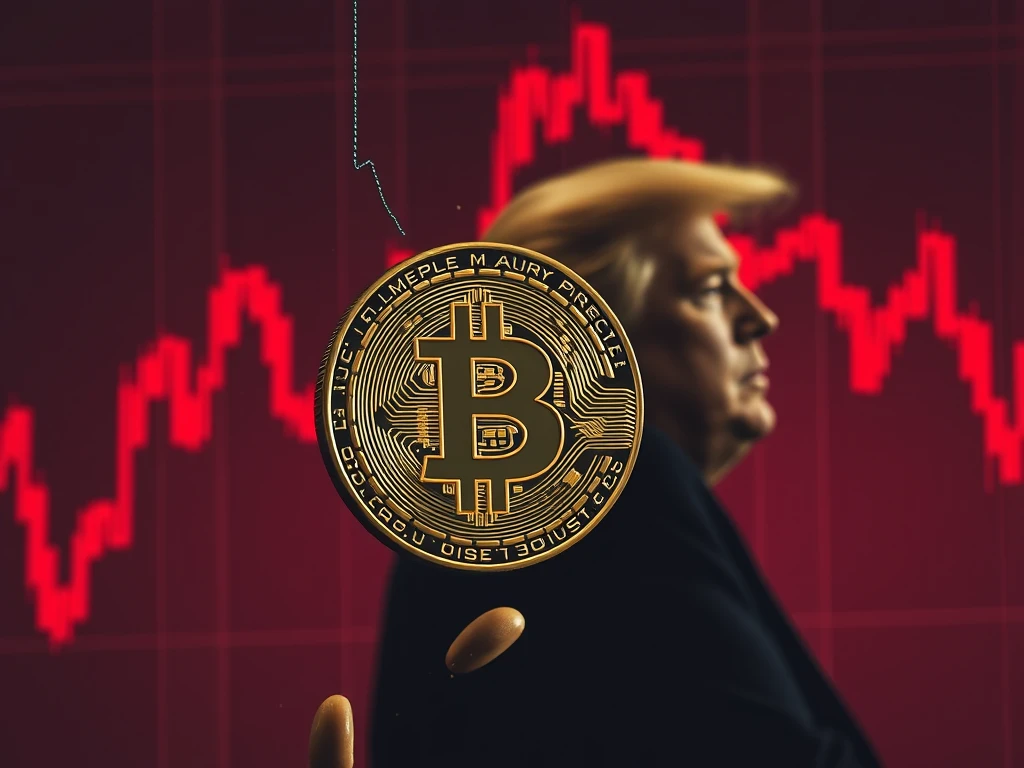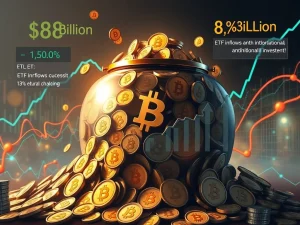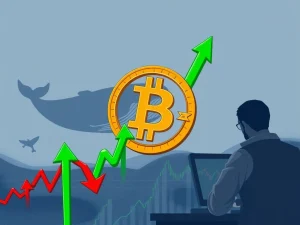Urgent Bitcoin Correction Warning: Price Dips to $81.5K Amid Trump Tariff Jitters

Hold onto your hats, crypto enthusiasts! Bitcoin (BTC) experienced a sudden jolt, tumbling to $81.5K as traditional markets shuddered in anticipation of former President Trump’s ‘Liberation Day’ tariff announcements. What’s fueling this market unease, and is this a temporary dip or a sign of deeper correction? Let’s dive into the details.
Why is the Bitcoin Price Reacting to Stock Futures?
The cryptocurrency market, often touted as being independent, is currently mirroring movements in traditional stock markets. This correlation is especially evident in times of economic uncertainty. As US stock futures began to bleed red, Bitcoin followed suit, slipping below the $82,000 mark. This synchronized movement underscores a crucial point: investor sentiment and macroeconomic factors are increasingly influencing Bitcoin’s price action.
Here’s a breakdown of what’s happening:
- Trump’s Tariff Threat: Former President Donald Trump’s looming announcement of new tariffs, dubbed ‘Liberation Day’ tariffs, is injecting anxiety into the markets. The anticipation of a 25% tariff on imported cars and potential tariffs on pharmaceuticals has spooked investors.
- Stock Futures Sell-Off: As a direct consequence of this tariff uncertainty, US stock futures are experiencing a sell-off. Dow Jones futures dropped by 206 points, and S&P futures declined by 0.56% at the time of writing.
- Bitcoin’s Bearish Trend: Bitcoin, reacting to this broader market sentiment, has registered its seventh consecutive day of lower lows, highlighting a clear bearish trend in the short term.
This market behavior suggests that investors are adopting a risk-off approach, moving away from potentially volatile assets like both stocks and cryptocurrencies in response to perceived economic threats.
Trump Tariffs and ‘Liberation Day’: What’s the Connection?
Former President Trump’s repeated references to April 2nd as ‘Liberation Day’ are central to understanding the current market jitters. This date is expected to be when ‘reciprocal tariffs’ are assigned to various countries, a move that has traders on edge. The lack of clarity and the potentially aggressive nature of these tariffs are creating significant uncertainty.
Why is this causing market anxiety?
- Trade War Fears: New tariffs could escalate trade tensions with other nations, potentially leading to retaliatory tariffs and a global trade war.
- Economic Slowdown: Tariffs can increase the cost of imported goods, leading to higher prices for consumers and businesses, potentially slowing down economic growth.
- Market Volatility: The uncertainty surrounding the scope and impact of these tariffs is driving volatility across financial markets, including both stocks and cryptocurrencies.
Market Analysis: Is This Just a Dip or a Deeper Correction?
Looking at the broader market analysis, March has been a challenging month for equities. The S&P 500 is down 6.3% for the month, while the Nasdaq and Dow have seen losses of 8.1% and 5.2%, respectively. Bitcoin’s decline mirrors this trend, raising questions about the short-term trajectory of the crypto market.
Several factors are contributing to Bitcoin’s current weakness:
- Weak Spot Market Demand: There appears to be a lack of strong buying pressure in the spot market, indicating that retail and institutional investors might be hesitant to buy at current levels.
- De-risking in Futures Markets: Traders are seemingly reducing their exposure in Bitcoin futures markets, suggesting a cautious or bearish outlook.
- Inflation Concerns: Recent PCE data showed higher-than-expected inflation, and consumer confidence is at a 12-year low. These economic indicators are painting a less optimistic picture and contributing to market unease.
- Recession Risks: Goldman Sachs recently increased the 12-month recession probability to 35%, citing weaker growth expectations and declining consumer and business confidence.
Goldman Sachs’ Recession Probability Upgrade: Key Takeaways
Goldman Sachs’ revised recession forecast is noteworthy. They highlight a shift in White House policy, indicating a greater tolerance for near-term economic weakness in pursuit of specific policy goals. This suggests that the current administration might be willing to accept some economic pain to achieve its objectives, which could further contribute to market uncertainty.
Is There a Silver Lining in This Bitcoin Price Drop?
While the short-term outlook might seem gloomy, some positive indicators are emerging. Despite revised bearish price targets from some analysts, institutional investors continue to accumulate Bitcoin. Spot Bitcoin ETFs are still experiencing net inflows, suggesting long-term confidence in the asset.
MicroStrategy CEO Michael Saylor, a prominent Bitcoin bull, reiterated his bullish stance on X, stating, “Needs even more Orange,” alongside his signature Bitcoin accumulation chart. This unwavering conviction from institutional players like Saylor provides a counter-narrative to the current bearish sentiment.
Data from CryptoQuant further supports this narrative, showing continued inflows of Bitcoin to accumulation addresses throughout March. This suggests that while short-term traders might be selling, long-term holders are using this price dip as an opportunity to accumulate more Bitcoin.
Final Thoughts: Navigating the Bitcoin Correction
The current Bitcoin price correction is undeniably linked to broader market anxieties surrounding Trump tariffs and macroeconomic uncertainties, particularly recession fears. While the short-term may remain volatile, the continued accumulation by institutional investors and long-term holders offers a glimmer of hope. Stock futures will likely remain sensitive to further news regarding tariffs and economic data. As always, remember that the cryptocurrency market is inherently risky. Conduct thorough research and consider your risk tolerance before making any investment decisions. This market analysis is for informational purposes only and not financial advice.
Disclaimer: This article does not contain investment advice or recommendations. Every investment and trading move involves risk, and readers should conduct their own research when making a decision.









